Article
Open Access
Wavefront properties of the anterior and posterior corneal surface after transepithelial photorefractive keratectomy in myopia
- Authors:
-
-
Pages:
1183-1188
|
Published online on:
December 17, 2019
https://doi.org/10.3892/etm.2019.8338
- Expand metrics +
Metrics:
Total
Views: 0
(Spandidos Publications: | PMC Statistics:
)
Metrics:
Total PDF Downloads: 0
(Spandidos Publications: | PMC Statistics:
)
This article is mentioned in:
Abstract
The present study aimed to evaluate the changes of corneal higher‑order aberrations (HOAs) after transepithelial photorefractive keratectomy (TransPRK) in patients with myopia. A total of 80 eyes of 80 patients with myopia with or without astigmatism were evaluated. Prior to and 1 year after the surgery, uncorrected and corrected distance visual acuity in logMAR were assessed. Wavefront aberrations on the anterior surface of the cornea, as well as the posterior and total cornea, were measured via Pentacam. The HOA of the anterior surface and total values of spherical and coma aberrations increased significantly (P<0.001). However, HOAs of the anterior surface, and posterior and total values of the trefoil were not significantly changed (P=0.442, 0.805 and 0.936, respectively). A significant correlation of the pre‑operative mean spherical equivalent refraction (MSER), astigmatism and central corneal ablation depth (CCAD) with the changes in coma aberration (r=0.268, P=0.016; r=0.260, P=0.020; r=0.323, P=0.004, respectively) and HOA (r=0.554, P<0.001; r=0.312, P=0.005; r=0.583, P<0.001, respectively) of the anterior surface of the cornea was determined. Furthermore, a significant correlation of the pre‑operative MSER and CCAD with the changes in spherical aberration of the anterior corneal surface (r=0.462, P<0.001; r=0.510, P<0.001, respectively) was obtained. In conclusion, TransPRK offers an effective option for improving visual function in patients with myopia. The anterior corneal HOA, as well as spherical and coma aberrations, were significantly increased post‑operatively. The HOA of the posterior cornea was not significantly changed. The change in the trefoil aberration was significantly correlated with pre‑operative astigmatism, but the pre‑ and post‑operative values were not significantly different.
View Figures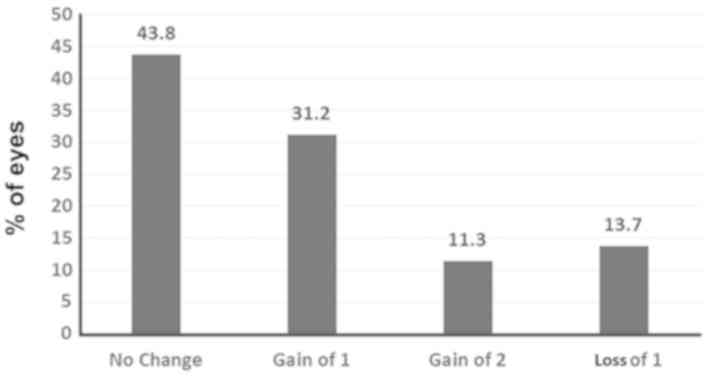 |
Figure 1
|
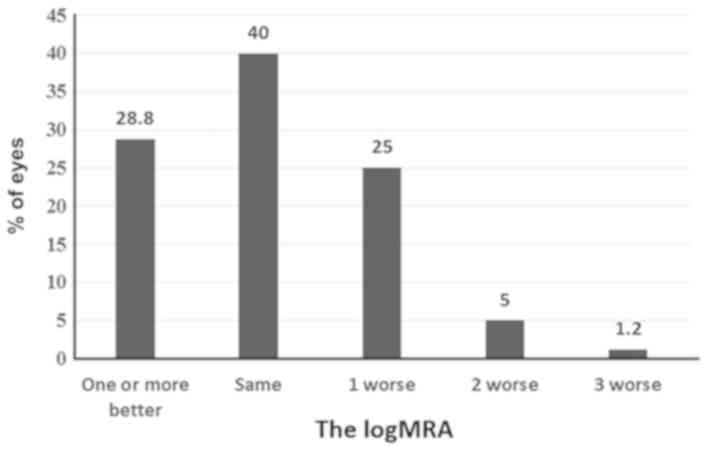 |
Figure 2
|
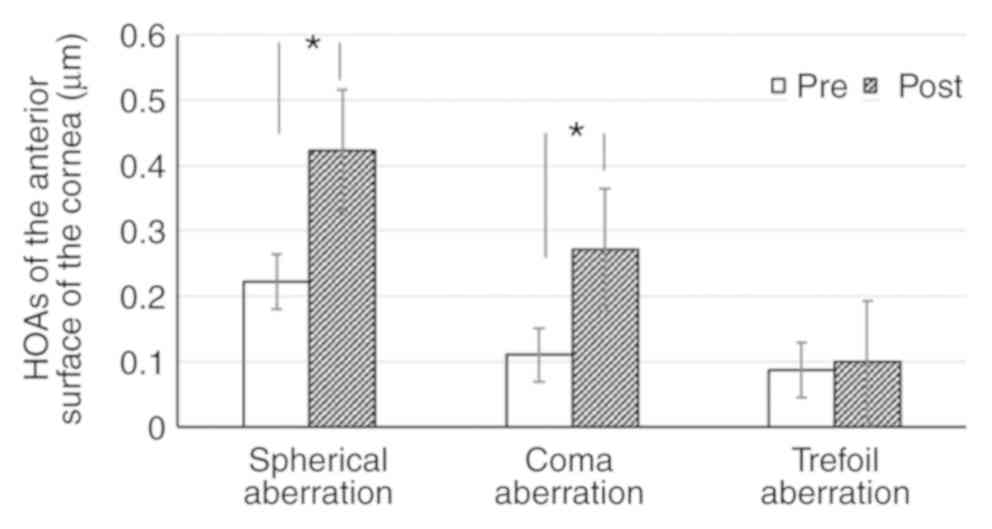 |
Figure 3
|
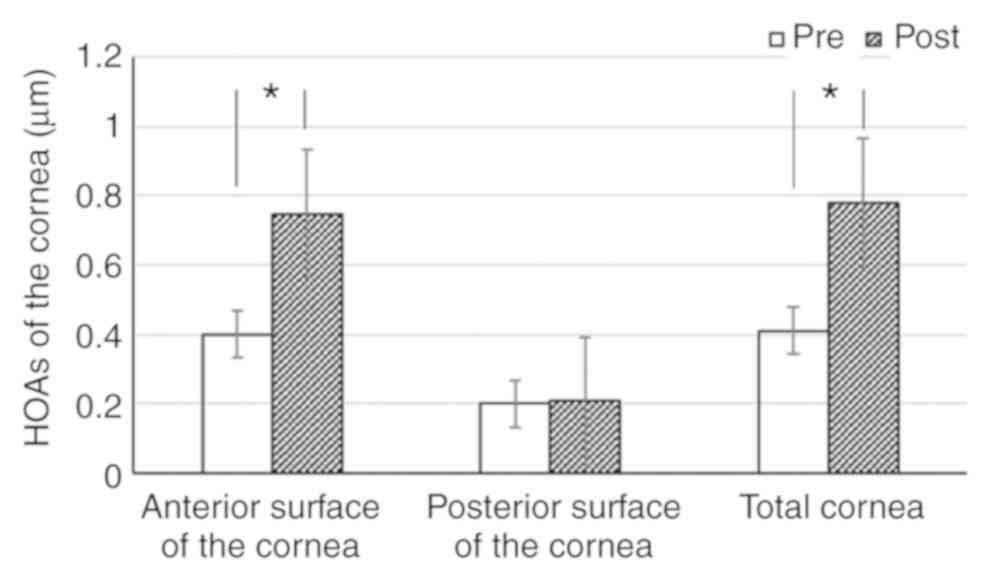 |
Figure 4
|
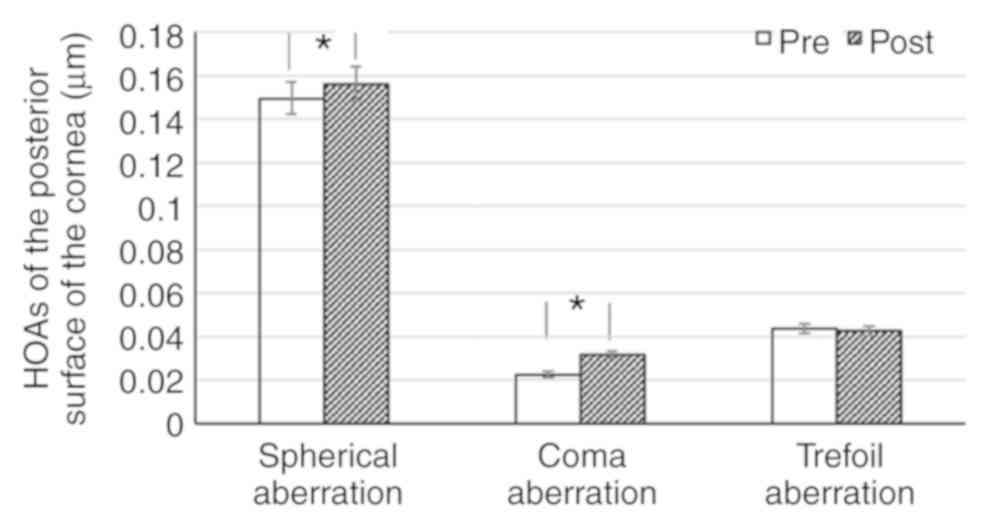 |
Figure 5
|
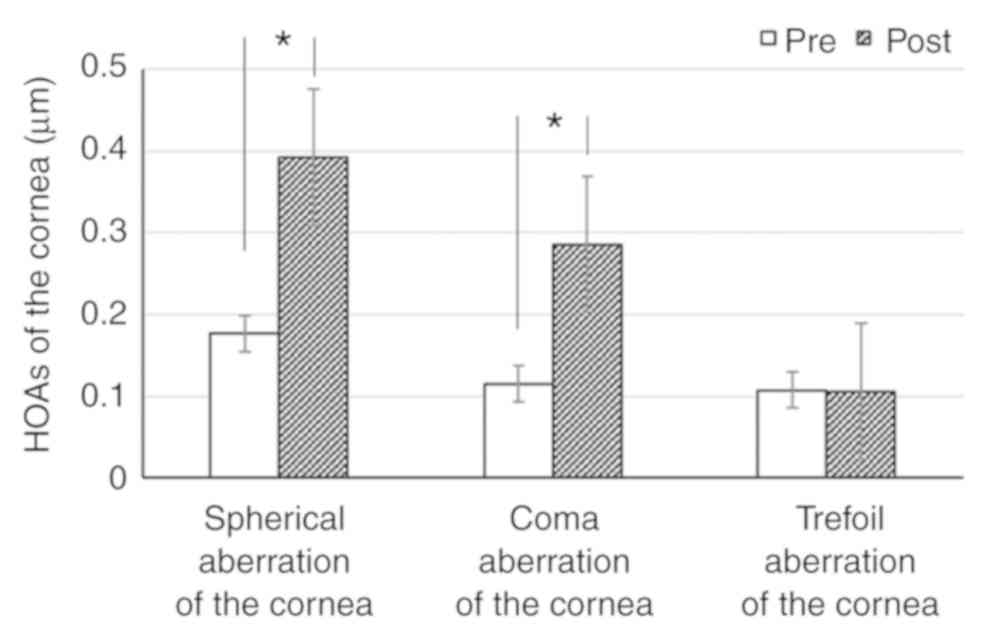 |
Figure 6
|
View References
|
1
|
Clinch TE, Moshirfar M, Weis JR, Ahn CS,
Hutchinson CB and Jeffrey JH: Comparison of mechanical and
transepithelial debridement during photorefractive keratectomy.
Ophthalmology. 106:483–489. 1999. View Article : Google Scholar : PubMed/NCBI
|
|
2
|
Arba Mosquera S and Awwad ST: Theoretical
analyses of the refractive implications of transepithelial PRK
ablations. Br J Ophthalmol. 97:905–911. 2013. View Article : Google Scholar : PubMed/NCBI
|
|
3
|
Ghadhfan F, Al-Rajhi A and Wagoner MD:
Laser in situ keratomileusis versus surface ablation: Visual
outcomes and complications. J Cataract Refract Surg. 33:2041–2048.
2007. View Article : Google Scholar : PubMed/NCBI
|
|
4
|
Reinstein DZ, Archer TJ, Gobbe M,
Silverman RH and Coleman DJ: Epithelial thickness in the normal
cornea: Three-dimensional display with Artemis very high-frequency
digital ultrasound. J Refract Surg. 24:571–581. 2008. View Article : Google Scholar : PubMed/NCBI
|
|
5
|
Juhasz E, Kranitz K, Sandor GL, Gyenes A,
Toth G and Nagy ZZ: Wavefront properties of the anterior and
posterior corneal surface after photorefractive keratectomy.
Cornea. 3:172–176. 2014. View Article : Google Scholar
|
|
6
|
Serrao S, Lombardo G, Ducoli P and
Lombardo M: Long-term corneal wavefront aberration variations after
photorefractive keratectomy for myopia and myopic astigmatism. J
Cataract Refract Surg. 37:1655–1666. 2011. View Article : Google Scholar : PubMed/NCBI
|
|
7
|
Lee SB, Hwang BS and Lee J: Effects of
decentration of photorefractive keratectomy on the induction of
higher orderwavefront aberrations. J Refract Surg. 26:731–743.
2010. View Article : Google Scholar : PubMed/NCBI
|
|
8
|
Adib-Moghaddam S, Soleyman-Jahi S,
Salmanian B, Omidvari AH, Adili-Aghdam F, Noorizadeh F and Eslani
M: Single-step transepithelial photorefractive keratectomy in
myopia and astigmatism: 18-month follow-up. J Cataract Refract
Surg. 42:1570–1578. 2016. View Article : Google Scholar : PubMed/NCBI
|
|
9
|
Kaluzny BJ, Cieslinska I, Mosquera SA and
Verma S: Single-step transepithelial PRK vs Alcohol-assisted PRK in
myopia and compound myopic astigmatism correction. Medicine
(Baltimore). 95:e19932016. View Article : Google Scholar : PubMed/NCBI
|
|
10
|
Aslanides IM, Padroni S, Arba Mosquera S,
Ioannides A and Mukherjee A: Comparison of single-step reverse
transepithelial all-surface laser ablation (ASLA) to
alcohol-assisted photorefractive keratectomy. Clin Ophthalmol.
6:973–980. 2012. View Article : Google Scholar : PubMed/NCBI
|
|
11
|
Miháltz K, Kovács I, Takács A and Nagy ZZ:
Evaluation of keratometric, pachymetric, and elevation parameters
of keratoconic cornea with pentacam. Cornea. 28:976–980. 2009.
View Article : Google Scholar : PubMed/NCBI
|
|
12
|
Bastawrous A, Silvester A and Batterbury
M: Laser refractive eye surgery. BMJ. 342:d23452011. View Article : Google Scholar : PubMed/NCBI
|
|
13
|
Aslanides IM, Georgoudis PN, Selimis VD
and Mukherjee AN1: Single-step transepithelial ASLA (SCHWIND) with
mitomycin-C for the correction of high myopia: Long term follow-up.
Clin Ophthalmol. 9:33–41. 2014. View Article : Google Scholar : PubMed/NCBI
|
|
14
|
Luger MH, Ewering T and Arba-Mosquera S:
Myopia correction with transepithelial photorefractive keratectomy
versus femtosecond assisted laser in situ keratomileusis: One-year
case-matched analysis. J Cataract Refract Surg. 42:1579–1587. 2016.
View Article : Google Scholar : PubMed/NCBI
|
|
15
|
Artal P, Chen L, Fernández EJ, Singer B,
Manzanera S and Williams DR: Adaptive optics for vision: The eye's
adaptation to point spread function. J Refract Surg. 19
(Suppl):S585–S587. 2003.PubMed/NCBI
|
|
16
|
Hou J, Wang Y, Lei Y, Zheng X and Zhang Y:
Corneal epithelial remodeling and its effect on corneal asphericity
after transepithelial photorefractive keratectomy for myopia. J
Ophthalmol. 2016:85823622016.PubMed/NCBI
|
|
17
|
Chen X, Stojanovic A, Liu Y, Chen Y, Zhou
Y and Utheim TP: Postoperative changes in corneal epithelial and
stromal thickness profiles after photorefractive keratectomy in
treatment of myopia. J Refract Surg. 31:446–453. 2015. View Article : Google Scholar : PubMed/NCBI
|




















